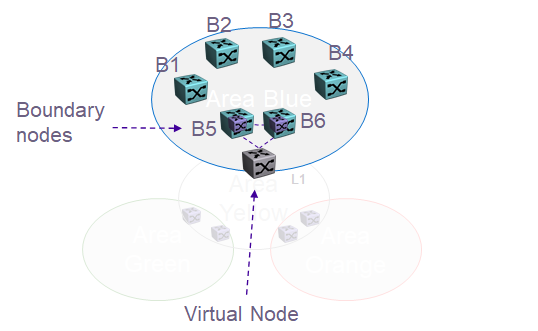Area Virtual Node
The designated boundary node in the Multi-area SPB network creates the area virtual node. The area virtual node sums up an entire network topology in a single virtual node representing all the services from the represented area.

When considering the shortest path between two nodes in different areas in the Multi-area SPB network, the area virtual node logically connects the shortest path within one area to the shortest path within another area. The area virtual nodes help the Multi-area SPB network to visualize any external area as a single IS-IS entity.
The boundary nodes in the Multi-area SPB network exposes one virtual node in each of two connected areas, to represent a collection of nodes from the other area. On the basis of the policies that you configure on the boundary nodes, you can control the services that the system exports from one area to the other area as the system includes the configuration in the Link State Packets (LSP) of the corresponding area virtual node.
You can configure the area virtual node parameters on both home and remote IS-IS instances. For more information about configuring the area virtual node, see Configure IS-IS Multi-area SPB Virtual Node.
Layer 2 Ping and Layer 2 Traceroute Support
Multi-area SPB supports Connectivity Fault Management (CFM) on boundary nodes in both home and remote area. For the remote area, the boundary nodes respond to the Layer 2 ping and Layer 2 traceroute messages that contain the remote area system ID. You must enable CFM on the boundary nodes for the functionality to work.
Multi-area SPB supports the following Layer 2 ping, Layer 2 traceroute, and Layer 2 tracetree interactions:
-
from boundary node to remote area Backbone Edge Bridge (BEB)
-
from remote area BEB to boundary node

Note
Multi-area SPB does not support CFM between the home and remote area.
The following list identifies CFM restrictions for virtual node interactions:
-
The boundary node cannot use Layer 2 ping or Layer 2 traceroute to the virtual node.
-
The virtual node does not reply to Layer 2 tracetree or Layer 2 tracemroute.
-
The virtual node does not initiate CFM messages.
For more information about CFM, see Connectivity Fault Management.

